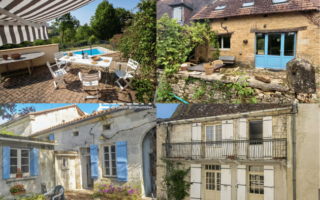How to become a landlord
Buy-to-let returns can be extremely lucrative in France, as Peter-Danton de Rouffignac explains
Among the different options for investing in French property, or buy to let, one of the less well-known markets is that of long-term annual rental apartments which are let furnished. Given the right location and type of property, they can be an attractive alternative to traditional letting – unfurnished, holiday lets etc – easy to manage and offering a secure return.
Out of a total of 27 million households in France, just over 11.6 million (40%) comprise individuals and families who rent rather than own their property, 6.55 million renting in the private sector. Since the mid-1980s, the number of institutional property investors has dropped dramatically and they now own less than 2% of the private rental sector, leaving a huge 98% to smaller private owner/investors.
One of the peculiarities of the rental sector is that renters tend to live in smaller properties than owners (who prefer individual houses), due mainly to the dominance of studios and two- to three-room apartments, which together comprise more than 60% of all French apartments.
Studios of 25m� average size make up around 15% of this sector. It is these in particular that are being targeted by a new breed of individual investors who buy, renovate and let furnished these smaller properties, normally on an annual lease.
CAPITAL RETURNS
One such investor is Elise Franck, a Parisian-based property owner, who has appeared on French television and, in a recently published book, recounts how, with few financial resources, she has built up a small individual property portfolio based in central Paris and is expanding into France’s second city, Lyon.
Her particular speciality is buying rundown studio apartments which she judges to have potential and which generally come onto the market 15-20% below the average market price. Using her talents as an interior designer, she undertakes a full renovation using high-quality materials, and equips and furnishes them for rental.
The surprising thing is how small they are – occasionally less than 20m� – and in her book, she shows examples where she has occasionally bought a ‘large’ apartment of just over 30m� and divided it into two smaller units. In certain well-chosen locations, there is a ready market for these tiny properties. You can see examples on her website. Of her career choice, and the market, Elise says: “I was working as a secretary in a bank and was bored. I knew I didn’t want to work my way up through the ranks and I also knew that I wanted to work for myself rather than someone else. My goal was to become financially independent and so I began investing in property, focusing on up-and-coming areas of Paris and cheaper apartments in the city, in order to transform them into something special.
“I focus on developing areas simply because the prices are lower than in the more central areas, and they are often more popular with younger people. Therefore there are often savings to be made on the purchase price and then further financial rewards on the rental price afterwards. In general I target apartments requiring total renovation so that I can optimise the transformation, or those that have already been renovated but in poor taste. In the case of the latter, we make the improvements through ‘home staging’, which can immediately improve a property.
“Some people think that prices have reached an all-time high and will now start to fall, but others like me are more optimistic and think that some of the large French cities, such as Paris, Lyon, Toulouse, the C�te d’Azur, Aix en Provence, Bordeaux, Montpellier or Lille, will see prices continue to rise, as a result of the growing demand for accommodation.”
By looking in less favoured areas of major cities – estate agents sometimes refer to them as ‘improving’ – Franck insists you can pick up the right kind of property for less than the market price, provided you are quick on your feet, have an eye for potential, and know how to organise and manage a renovation project. Taking Paris as an example, she has favoured districts north of the centre (18th, 19th and 20th arrondissements) which are becoming increasingly popular with young people – and in particular, renters who do not see these small apartments as their permanent home.
Typically, these renters are studying or on a work secondment for a limited period and do not have the desire to buy – or even rent and furnish – a similar empty small property.
The regulations regarding furnished properties let on an annual agreement are less onerous than those for longer-term unfurnished rentals, which include a range of in-built protections for occupiers, as for many, the rental represents their permanent home. In contrast, the shorter term furnished property is designed for a certain type of tenant, as noted above, and the monthly rental is generally considerably higher than for the equivalent type of unfurnished property.
WHAT CONSTITUTES ‘FURNISHED’?
The legal definition of ‘furnished’ is when a property is equipped and furnished ‘for normal living’, and includes as a minimum a working kitchen, bath or shower-room, WC, a bed, storage for clothes etc, table, chairs, sofa, curtains, all appropriate to the particular property and enabling the tenant to take up residence without having to provide their own.
In a high-quality rental, equipment provided would routinely include a washing machine and dishwasher, even in the tiniest units. Many can include a mezzanine and every extra square inch of storage space greatly adds to the apartment’s potential value.
High-quality modern furnishings are essential and details such as an attractive bath or shower-room, wood floors and bright painted walls will attract tenants willing to pay to occupy a well-designed and convenient small space.
In selecting the sort of property intended for furnished letting, short-term tenants are known to have certain preferences and at the same time may accept some limitations (including size!) that might deter investors searching for a property they would like to live in themselves. Ground floors are generally to be avoided due to street noise and lack of light, whereas higher floors – such as attics and former chambres de bonnes (maids’ rooms) – are popular with young renters, even in older properties without a lift – after all, they won’t be hauling the furniture up all those flights of stairs when they move in, and their solo shopping expeditions tend to be lighter and more frequent.
There is generally no demand for private car parking – impossible or expensive in city centres – but easy access to public transport and local shops, restaurants and bars, however, are a definite plus.
The general state of repair of the building – outside fa�ade, halls, stairways etc – is of small concern to renters who do not intend to stay for more than a year or two, and high building charges may discourage short stayers who are not interested in adding value to the property.
Lack of natural light can be a drawback, where even a high floor can be in the shadow of a nearby building, but again even this can be overcome by imaginative window treatment. The secret, according to experts in home staging, is to work with what you can change and live with what you can’t.
TRACK RECORD
On the economics of small property investment, Elise Franck recounts how she used her capacity to borrow – while she had a full-time job – to finance her first project, and over the years, with a mixture of reselling one or two earlier acquisitions and in some cases even paying cash for a new purchase, she has managed to retain her ‘bankability’ (now based on her track record as a property investor) and to live comfortably off her rentals and other income.
As a small property owner, selling off one or two of properties does not put you into the category of a marchand de biens (property dealer) provided it is done judiciously and not too often. The French fiscal authorities recognise a category of non-professional furnished property letter (loueur en meubl� non professionnel or LMNP) in contrast to a (full-time) professional occupation. The LMNP has to have another source of income besides the rentals, which need to kept below a certain annual minimum (currently €23,000 per year) and represent less than 50% of your (household’s) annual income from other sources such as salaries or fees.
The normal fiscal regime is the micro-BIC and it is possible to elect for a forfait (fixed scale of tax relief) or deduct (part of) certain real costs such as interest, legal fees, insurance and depreciation against the taxes associated with the letting operation.
Professional advice should be sought in all cases as to choice of regime and whether to operate as a full-time professional or as an ‘amateur’, as changes in the regulations are frequent and can impact on your revenues. In her book and on her website, Elise Franck reveals precise details of purchase costs, renovation, rental charged, rate of return and income received from a sample of properties (see the examples, left).
If you decide to become a professional loueur en meubl� professionnel, you have to register the enterprise with the local chamber of commerce and become subject to the normal tax and social security regulations. However, the fiscal regime offers several attractive advantages such as recovery of VAT paid (for example on renovation and furnishings), and generous allowances for loan interest, depreciation etc.
Among the practical advantages of owning and letting short-term furnished apartments – as opposed, for example, to seasonal holiday lettings – is that rentals tend to be higher, annual tenancies are relatively trouble-free, and you do not have the job of continually advertising, marketing and managing your properties between tenants.
By spreading your risks and owning a small property portfolio you can go some way towards reducing the risks of bad payers or having an un-let property on your hands, and retain the option to sell-off a property more or less when you choose.
Peter-Danton de Rouffignac MA LLM lives near Perpignan and advises on property buying in France.
www.FranceMedProperty.blogspot.com
Share to: Facebook Twitter LinkedIn Email


